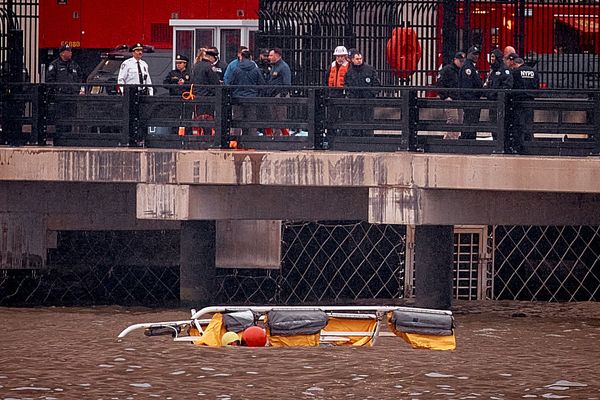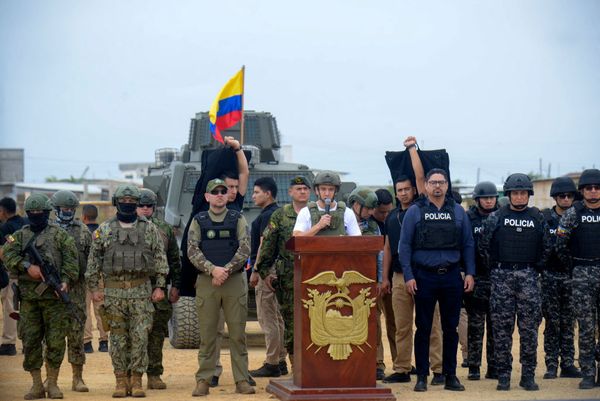
A decision by Colorado state regulators to put two multiwell oil and gas proposals on hold showcased the growing influence of Denver-area antidrilling groups that have organized over the last decade in the face of large fossil fuel developments proposed on the outskirts of their suburban neighborhoods.
Colorado’s Energy & Carbon Management Commission in November rejected a controversial request by Extraction Oil & Gas Inc. to build a 26-well oil operation, known as the Draco pad, in fossil fuel friendly Weld County and use it as a platform to drill under the town of Erie, which has fought to keep its land free from gas and oil extraction.
In early January, the five-member body also denied for now an application by a smaller operator to construct a 20-well pad about 45 minutes to the southeast. The so-called Secret Stash project would have been drilled on a former bombing range that’s also slated for scores of additional wells.
If constructed, both developments would have been less than a mile from the fast-growing suburbs that ring the state’s capital. The decisions to block the drilling for now marked a milestone for community organizations that have lobbied the state’s oil and gas agency for years to move drilling operations farther away from their homes.
“I would suggest that before any of these are permitted that the commission and other agencies do a bit more homework and do some simple math,” Randy Willard, a 36-year resident of nearby Aurora, testified at the Jan. 8 hearing on the Secret Stash pad.
“They will see that the impact of Secret Stash does not stand alone and in fact adds to the impacts of the area considerably,” added Willard, who is among scores of members of Save the Aurora Reservoir, a neighborhood nonprofit group created to fight multiwell pads proposed within several miles of homes.
Both developments put on hold by state regulators underscored the challenges energy companies face in tapping lucrative shale deposits miles below the sprawling neighborhoods along what’s known as Colorado’s Front Range. As drilling moved ever closer to communities, state legislators enacted a unique law in 2019 that required the energy commission to prioritize health, safety and the environment over industry profits.
Capital & Main reached out to Civitas Resources Inc., the parent company of Extraction Oil & Gas, for a response. The company did not respond.
Extensive new rules outlined in a state Senate bill also required energy companies to provide officials with more information about how hydrocarbon extraction projects affect traffic, air emissions and water use. This additional data gives regulators more sway over how and when pads are constructed.
As written, Senate Bill 181 also gave greater authority to municipalities over oil and gas operations within their boundaries and required that community groups be allowed additional opportunities to influence the process.
The dramatic shift in Colorado’s fossil fuel regulatory environment, and the subsequent power it’s given residents, is affecting the market value of oil and gas companies and causing operators to question the economics of doing business in the state, industry analysts said.
Civitas Resources Inc., the parent company of Extraction, whose Draco pad the commission placed on hold in November, is exploring the sale of extensive assets it holds in the region’s Denver-Julesburg basin, according to a Jan. 15 report in Bloomberg News. The holdings reportedly include the Lowry Ranch Comprehensive Area Project, a 166-well project that led to the creation of Save the Aurora Reservoir.
“A potential sale would remove the market/investor stigma associated with Colorado, which is weighing on the valuation,” Gabriele Sorbara, an analyst at Siebert Williams Shank & Co. LLC, told Reuters. “Investors do not want to touch Colorado-focused E&Ps,” or exploration and production companies.
The reasons Colorado’s energy commission gave for placing the Secret Stash and Draco multiwell projects on hold varied. On the Secret Stash pad application, state regulators asked the operator to clarify how many times it planned to drill on the pad and how many truck trips and air emissions would result from drilling on the site.
“It’s not clear what is being proposed,” Commissioner John Messner said. Multiple trips to drill on the site “also means additional truck trips, which means additional emissions, which means additional impacts.”
The company proposing the Secret Stash development, GMT Exploration Co. LLC, told the commission it wanted to start with several wells to determine the hydrocarbon production potential in the area.
“Initially it will likely be two to six wells,” Maxwell Blair, the privately held company’s regulatory manager, told the commission before it denied the project. “It’s not totally clear whether all 20 will be developed at this point.”
The commission asked that GMT rework its application to better specify air, water and other effects it expected to result from operations it planned at the site.
GMT did not respond to Capital & Main’s request for comment.
In Erie, the state’s energy commission ordered Extraction Oil & Gas Inc. to consider constructing the Draco pad on an alternate site within the picturesque town. That parcel, already home to 29 wells, two landfills and a Superfund site, would give the town authority to regulate operations that affect its residents, commissioners said.
“To me this application is very challenging,” Commissioner Brett Ackerman said at a Nov. 15 online hearing about the original site in Weld County, next door to the town of Erie. “On one hand, it includes many best-in-class practices we often encourage, and on the other hand, there are multijurisdictional issues.”
Commissioners voted unanimously to put the plan on hold after an eight-hour hearing on the proposal spread over two days. The hearing included testimony from Erie residents who already have oil and gas wells in their backyards or feet from their homes or children’s schools.
The commissioners required Extraction to conduct a “full alternative location analysis” of a site known as Redtail Ranch, a highly contaminated area that was once envisioned as a master-planned community .
Residents’ reactions to the commission’s ruling were mixed. There was little celebration, as the decision would merely move the effects of the industrial operation to the doorstep of other neighborhoods. And the well bores would still be drilled under communities that already have scores of existing wells — including some that need to be plugged and abandoned.
“We will prepare to vigorously oppose [the alternative site] should they make an actual effort to pursue that,” said Christiaan van Woudenberg, a resident who can see the Redtail Ranch site from his back deck. “Until then we are in the shock phase wondering, ‘Do we have to do this again, to fight for our health and safety and the ability to spend time outdoors?’”
When the existing wells were drilled and fracked — a process in which sand and water are injected down a well to release oil and gas trapped in shale miles beneath the surface — on the ranch in 2017, the noise from diesel generators kept van Woudenberg awake for months. The disruption dysregulated his nervous system and forced his neighbors to put 2-inch plastic foam pads in their windows, he said.
Extraction said in its drilling application to regulators that the Redtail Ranch location was among several alternatives for the pad that were deemed unfeasible “due to local regulations.”
The company said it chose the 20-acre site in Weld County in part because electricity is available to power drilling and fracking equipment, allowing it to forego diesel generators. Commissioners applauded the plan, citing the fact it would cut down on toxic emissions and noise.
Even so, the five-member body expressed concerns about the pad’s location on the outskirts of a planned 3,100-home community, with homes priced between $500,000 and $1.5 million.
The drilling site would be within 2,000 feet of at least 70 residences, a park, walking trails and a school. To reach minerals under the town of Erie, Extraction asked to drill some of the longest horizontal bores ever proposed in Colorado that would run contiguous to existing wells. Residents and town officials expressed fear about the potential for interaction between older wells and the newer bores.
The Draco pad is proving to be a test case for what happens when local oil and gas rules are misaligned. Extraction proposed drilling in Weld County, which requires only a 500-foot setback — less than a length of two football fields — between wells and homes. The town of Erie meanwhile mandates 2,000 feet between the two. The issue is further complicated because Erie is bifurcated by Weld and Boulder counties. The latter enacted a moratorium on drilling in the 2010s. Yet the wells would extend underground from the Draco pad into Boulder County.
But the county, like the town of Erie, has no jurisdiction over the application because the pad on which the wells would be drilled is located next door in Weld, the state’s largest oil and gas county. The jurisdictional confusion triggered by the geographic location of the Draco pad was evident throughout the two-day online hearing on Extraction’s proposal.
“From a land-use perspective, this is a good location,” Jason Maxey, then-director of Weld County’s energy department, said during the November hearing. He said the county determined the application complied with its code requirements and approved it in February 2024. Four alternate locations were considered, he said, and the proposed site chosen was the one that best mitigated effects on residents.
Extraction echoed Maxey’s comments that none of the alternative parcels were viable. This is particularly true of the Redtail Ranch alternative, company representatives said, even though it’s farther from homes and industrial activities that already exist on the site.
“We thought it would be highly unlikely the town of Erie would approve an oil and gas location zoned heavy industrial 2,005 feet away from a residential development to the south,” Jeff Annable, Extraction’s manager of well and location permitting, said at the November hearing
Indeed, the Redtail Ranch location is beset by challenges. Existing oil and gas operations there racked up the highest number of complaints in the state, most from nearby communities. The acreage would need to be rezoned from agricultural/residential to industrial. And questions remain about the presence of water and whether toxic contaminants already on the site were adequately cleaned up.
David Frank, Erie’s environmental services department director, told Capital & Main he met with Extraction in early January to discuss the process for submitting an application to drill on the Redtail Ranch site. The firm would also need to meet with the planning department to begin the rezoning process, Frank said.
It is unclear if rezoning must be completed before the company could request that the Erie Town Council approve an oil and gas permit for the site, he said. Additional analysis is also necessary to determine if the location is more protective of residents, he said.
“The purpose of the alternative location analysis is not to find the most convenient, or easily permitted location,” Frank said. “The fact that the mineral estate they are pursuing is largely in Boulder County, and portions of it under the town of Erie, perhaps those are the local governments that should be granted siting authority.”
The Erie Town Council rejected an application from Stratus Companies to build homes on the Redtail Ranch site in June, citing existing industrial activities that include a landfill shuttered in 2020, a 1960s-era waste disposal site so toxic that it required a cleanup overseen by the U.S. Environmental Protection Agency, an operating landfill and two active oil and gas pads. One council member called the property “spectacularly contaminated.”
Oil and gas operations on the site over the last seven years also drew hundreds of complaints from nearby communities. Van Woudenberg, the Erie resident who lives across the street from the site, created a website to educate people how to file reports about health effects, noise, light and traffic they observed at fossil fuel sites. He then mobilized residents by putting door hangers on homes.
The action resulted in about 905 noise, odor, light and air quality complaints to be filed against Crestone Peak Resources LLC, which operates two pads on the Redtail Ranch site, documents show. The company is a subsidiary of Civitas Resources Inc., as is Extraction Oil & Gas Inc., the firm that submitted the Draco pad proposal.
Residents of 26 neighborhoods that would be affected by Extraction’s proposal to drill under their homes held a community picnic a few days after the commission’s Nov. 15 decision and recommitted to opposing the project, no matter its location.
“There’s a growing engagement, an excitement, passion and breadth of experiences and backgrounds behind this movement,” Erie resident Sami Carroll, who created the Flatiron Meadows Oil & Gas Monitoring Group in early 2024 to oppose the Draco pad, told Capital & Main.
“I had a woman tell me we’ve changed the face of activism in Erie — this has become bigger and more impactful in so many ways,” Carroll added.







